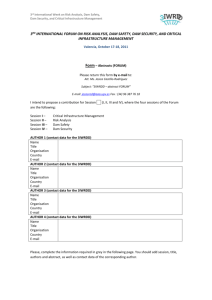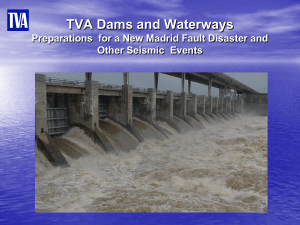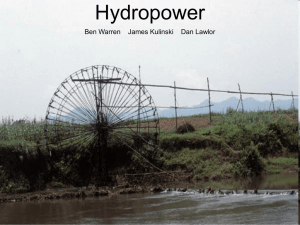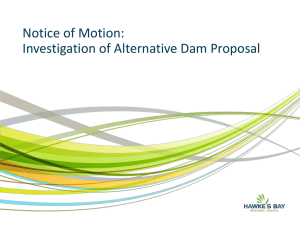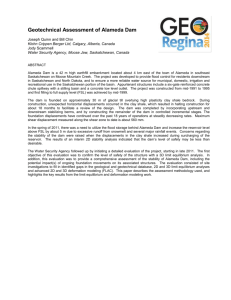File
advertisement
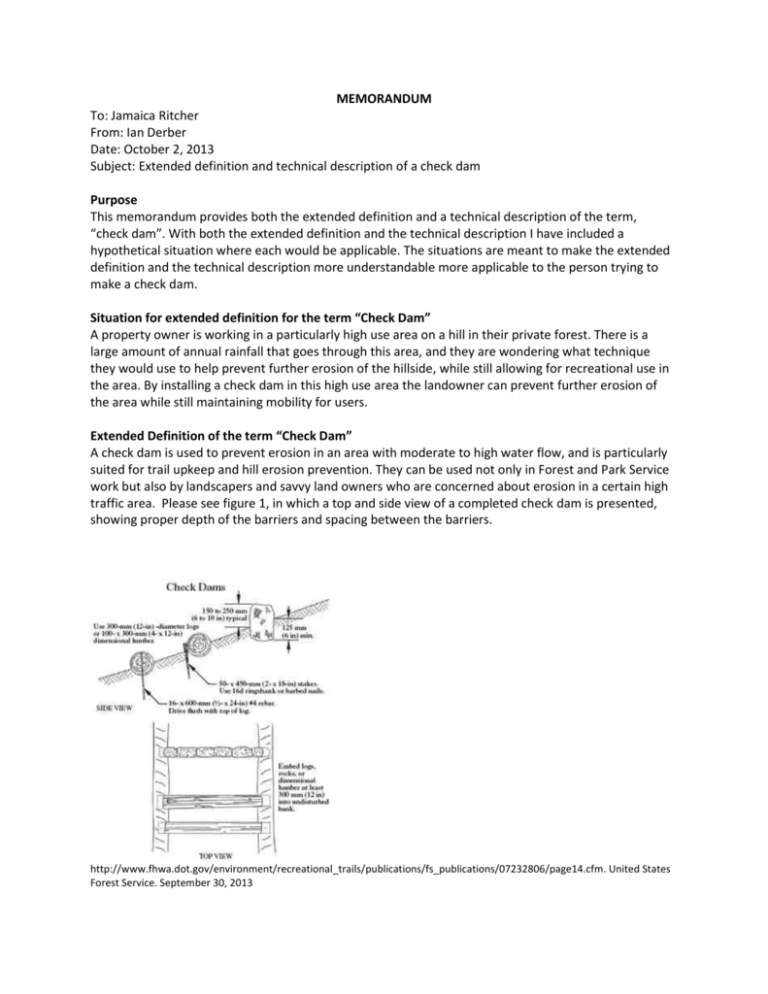
MEMORANDUM To: Jamaica Ritcher From: Ian Derber Date: October 2, 2013 Subject: Extended definition and technical description of a check dam Purpose This memorandum provides both the extended definition and a technical description of the term, “check dam”. With both the extended definition and the technical description I have included a hypothetical situation where each would be applicable. The situations are meant to make the extended definition and the technical description more understandable more applicable to the person trying to make a check dam. Situation for extended definition for the term “Check Dam” A property owner is working in a particularly high use area on a hill in their private forest. There is a large amount of annual rainfall that goes through this area, and they are wondering what technique they would use to help prevent further erosion of the hillside, while still allowing for recreational use in the area. By installing a check dam in this high use area the landowner can prevent further erosion of the area while still maintaining mobility for users. Extended Definition of the term “Check Dam” A check dam is used to prevent erosion in an area with moderate to high water flow, and is particularly suited for trail upkeep and hill erosion prevention. They can be used not only in Forest and Park Service work but also by landscapers and savvy land owners who are concerned about erosion in a certain high traffic area. Please see figure 1, in which a top and side view of a completed check dam is presented, showing proper depth of the barriers and spacing between the barriers. http://www.fhwa.dot.gov/environment/recreational_trails/publications/fs_publications/07232806/page14.cfm. United States Forest Service. September 30, 2013 Situation for the technical description for the term “Check Dam” A certified trail crew supervisor for the United States Forest Service (USFS) is teaching their new trail crew how to construct a check dam to properly prevent further trail erosion on a high traffic area in a national forest. The trail crew supervisor goes to the regulation how-to manual of the USFS containing the proper technical description of what a check dam is. Technical description for the term “Check Dam” A check dam is a barrier meant to hold back water and prevent the erosion of sediment on a downhill slope. These dams can be as extensive or simple as need be, based on the slope and how long the hill is. These barriers are usually made from all natural materials, typically including: dirt, logs and rock. However some synthetic materials such as plastic or metal have been used as substitutes. They are made from the following steps. First the builder must decide which slopes need the most erosion control, meaning which trails or hills get washed out the most and are losing the most sediment. From there, the builder must decide how many sections of the dam they are going to build. Most dams have a three to four foot flat area followed by the stone, log, metal or plastic barrier. While deciding how many sections to be put in, the builder must consider the steepness and length of the slope. The steeper or longer the slope, the more sections must be constructed. From there, the builder must start to mark out where the barriers are going, and where the flat areas are. The builder must then dig holes in the ground to set the barrier in place and prevent them from moving. The depth of the hole will vary depending on the size of the barrier material. For all materials however, there should be five to six inches of exposed material above the soil line so as to hold back some of the water. The reason that we leave that much of the barrier sticking out above the soil is not only to hold back water however, it is also meant to allow sediment to settle, that way soil loss is prevented, or at the very least slowed down. From there the builder must make sure that the downhill side of the barrier is secured so that it will not get washed away by heavy water flow. Usually when using stone this is not necessary, however with logs or other materials, wooden or metal stakes in the ground behind the barrier will keep them steady. The next step is to level out the middle flat area. These areas are meant to catch and collect water before they intentionally overflow the barrier and move down to the next level. By doing this we slow the downhill speed of the water making it less detrimental to the hillside, and we allow sediment to settle out, helping to replace previously eroded parts of the hillside. Now that the check-dam has been completed, it time to wait for it to rain and see where the water flows. If there is still too much water flow over the dams or some of the barriers are already coming loose, the builder must go back and either add more steps to the dam, or gather more sturdy blocking material and make sure that they are buried adequately enough. In a last ditch effort the builder may even have to go even further and add in culverts or tubes under the dams to help move excessive water flow away from problem areas. If all of these tasks are done properly, the check-dam should effectively prevent excessive amounts of water and soil from being eroded away from the target area, thus allowing for continued enjoyment of the area from visitors, or land owners.



